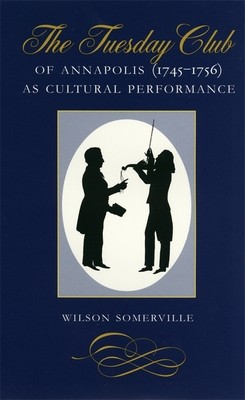
- We will send in 10–14 business days.
- Author: Wilson Somerville
- Publisher: University of Georgia Press
- ISBN-10: 0820318221
- ISBN-13: 9780820318226
- Format: 14.7 x 22.4 x 2.4 cm, kieti viršeliai
- Language: English
- SAVE -10% with code: EXTRA
The Tuesday Club of Annapolis (1745-1756) as Cultural Performance (e-book) (used book) | bookbook.eu
Reviews
Description
To be associated with the Tuesday Club of Annapolis was to reach the apogee of mid-eighteenth-century, upper Chesapeake male society. Founded by Dr. Alexander Hamilton, the club engaged in a range of self-conscious, stylized activities that, when viewed as "social performance," says Wilson Somerville, sharpen our understanding of the flux of cultural forces within British America and the place of such colonial groups in an emergent, transatlantic "bourgeois public sphere."
Using a combination of literary, historical, and sociological approaches, Somerville first examines the aesthetic dimensions of club performance and then its social and political aspects as he places the club in five major contexts: as a group with a self-consciously dramatic deportment, as a literary guild that regulated themes and rhetorical forms, as a media station in an international knowledge network, as an institution that defined an ideal of sociability in relation to the Chesapeake household, and as a mock state within which members wielded authority. The club, says Somerville, provided a semi-private sphere of interaction that was distinct from members' daily social order. Through the club, members tried to understand, negotiate, and mitigate the tensions of their lives arising from contradictions between brotherhood and empire, autonomy and sociability, the provincial and the metropolitan, the public and the private, and the solemn and the frivolous. To appreciate the extent to which members made sense of their world through the club, says Somerville, one must attend not only to the various modes of written, oral, and musical expression members employed, but also to the pageantry and theatrics, the self mockery and role-playing that marked their activities, and even to club regalia and its seating arrangements. Drawing on a wide range of period resources, The Tuesday Club of Annapolis will diversify our approaches to the literature and culture of the colonies and further reveal the limits of nationalist and regionalist outlooks to their study.EXTRA 10 % discount with code: EXTRA
The promotion ends in 21d.14:03:07
The discount code is valid when purchasing from 10 €. Discounts do not stack.
- Author: Wilson Somerville
- Publisher: University of Georgia Press
- ISBN-10: 0820318221
- ISBN-13: 9780820318226
- Format: 14.7 x 22.4 x 2.4 cm, kieti viršeliai
- Language: English English
To be associated with the Tuesday Club of Annapolis was to reach the apogee of mid-eighteenth-century, upper Chesapeake male society. Founded by Dr. Alexander Hamilton, the club engaged in a range of self-conscious, stylized activities that, when viewed as "social performance," says Wilson Somerville, sharpen our understanding of the flux of cultural forces within British America and the place of such colonial groups in an emergent, transatlantic "bourgeois public sphere."
Using a combination of literary, historical, and sociological approaches, Somerville first examines the aesthetic dimensions of club performance and then its social and political aspects as he places the club in five major contexts: as a group with a self-consciously dramatic deportment, as a literary guild that regulated themes and rhetorical forms, as a media station in an international knowledge network, as an institution that defined an ideal of sociability in relation to the Chesapeake household, and as a mock state within which members wielded authority. The club, says Somerville, provided a semi-private sphere of interaction that was distinct from members' daily social order. Through the club, members tried to understand, negotiate, and mitigate the tensions of their lives arising from contradictions between brotherhood and empire, autonomy and sociability, the provincial and the metropolitan, the public and the private, and the solemn and the frivolous. To appreciate the extent to which members made sense of their world through the club, says Somerville, one must attend not only to the various modes of written, oral, and musical expression members employed, but also to the pageantry and theatrics, the self mockery and role-playing that marked their activities, and even to club regalia and its seating arrangements. Drawing on a wide range of period resources, The Tuesday Club of Annapolis will diversify our approaches to the literature and culture of the colonies and further reveal the limits of nationalist and regionalist outlooks to their study.

Reviews